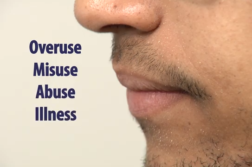CINCINNATI, Ill. (Ivanhoe Newswire) — One in 44 kids in the United States has autism, and as they get older and go out on their own, sticking to the healthy routines they adopted during childhood can be tough. But there are some lessons parents can reinforce to put young adults with autism and intellectual disabilities back on a healthy path.
A yogurt-based fruit smoothie is Dustin Stein’s go-to snack. This is a pretty recent change for him.
Stein says, “I ate a whole container, a whole bag of marshmallows one time.”
Mom, Suzanne, says Dustin’s eating habits went downhill after high school.
Suzanne states, “Dustin’s diet completely changed to let’s have a bunch of french fries and soft drinks and that was about it.”
Laura Nabors studies the health of young adults with autism, who are at higher risk for obesity, diabetes and cardiovascular disease.
Laura Nabors, PhD Human Services Professor University of Cincinnati, says “Some of their medications tend to cause increased weight. They may have some food selectivity preferences for just certain foods and it could be high carb foods.”
Nabors oversees a healthy lifestyle program, emphasizing the MyPlate model – five food groups that are important parts of a daily diet.
Nabors uses visual cues to explain portions- for example, think of a thumb as the amount of fats you should eat. Two fists equals two portions of vegetables. A playing card is the size of a serving of protein.
At home, she tells parents to involve young adults in planning, shopping and food prep.
Now, Dustin walks with his parents most nights. And he’s curbing his sugar habit.
Dustin says, “I try to set a limit on how much cookies I eat in one sitting.”
A good goal for everyone, regardless of life circumstance.
The University of Cincinnati researchers say of the young adults in the program, 44 percent increased their veggie intake, 70 percent reduced the soda they drank, and over 60 percent began walking or exercising more.
Contributors to this news report include: Cyndy McGrath, Producer; Roque Correa, Editor and Kirk Manson, Videographer
Sources:
https://www.cdc.gov/ncbddd/autism/addm.html
https://en.wikipedia.org/wiki/MyPlate#/media/File:USDA_MyPlate_green.svg
BACK ON TRACK: HEALTH HACKS FOR YOUNG ADULTS WITH AUTISM
REPORT #2989
BACKGROUND: Autism, or autism spectrum disorder (ASD), refers to a wide range of conditions characterized by challenges with social skills, repetitive behaviors, speech, and nonverbal communication. According to the Centers for Disease Control, autism affects an estimated one in 44 children in the United States. There are many subtypes of autism which are mostly influenced by a combination of genetic and environmental factors. These factors are often accompanied by sensory sensitivities and medical issues such as gastrointestinal disorders, seizures, or sleep disorders, as well as mental health challenges such as anxiety, depression, and attention issues. Signs of autism usually appear around ages two or three. Some associated development delays can appear even earlier, and often can be diagnosed as early as 18 months. Research shows that early intervention leads to positive outcomes later in life.
(Source: https://www.autismspeaks.org/what-autism)
AUTISM AND HEALTHY LIFESTYLE: Healthy eating in childhood is especially important for children with ASD who have an increased risk for excessive weight gain, selective eating, and nutrient deficiencies. Starting with a regular meal and snack schedule is important. Most people need to eat every two and a half to three and a half hours which typically covers breakfast, lunch, and dinner, and two to three snacks. Children should eat from all five major food groups including fruits, vegetables, grains, meats and beans, and dairy. Each of these groups provides a different set of vitamins, minerals, and macronutrients like carbohydrates, proteins, and fats. Many children with autism benefit from a visual schedule, so creating something that they can look at and see or read is important. Limiting access to sugar-sweetened beverages, such as juice and soda, is also extremely important. Limit juice to no more than 8 ounces a day and avoid soda whenever possible. Establishing these healthy eating patterns for children with autism will help set them up for better health outcomes as they get older.
NEW DIAGNOSTIC INDICATOR: Research by Susan Mayes, professor of psychiatry at Penn State College of Medicine, found that atypical eating behaviors were present in 70 percent of children with autism, which is 15 times more common than in neurotypical children. Atypical eating behaviors may include severely limited food preferences, hypersensitivity to food textures or temperatures, and pocketing food without swallowing. According to the research, these behaviors are present in many one-year-old children with autism and could be an indicator to doctors and parents that a child may have autism. Previous studies have shown applied behavior analysis to be most effective if implemented during the preschool years. Keith Williams, director of the Feeding Program at Penn State Children’s Hospital, uses this therapy to help a variety of individuals with unusual eating behaviors. “When we evaluate young children with multiple eating problems, we start to wonder if these children might also have the diagnosis of autism,” Williams said. The study data shows that atypical eating behaviors may help diagnostically distinguish autism from other disorders.
(Source: https://www.sciencedaily.com/releases/2019/07/190709141255.htm)
* For More Information, Contact: Laura Nabors Angela Koenig, PR
laura.nabors@uc.edu angela.koenig@uc.edu
Free weekly e-mail on Medical Breakthroughs from Ivanhoe. To sign up: http://www.ivanhoe.com/ftk



